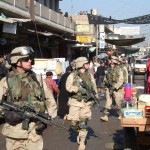Considering the misleading claims made about non-existent Iraqi and Iranian nuclear weapons, and the ramifications of another costly and catastrophic war, there should be more analyses like Scott Peterson’s highlighting of lessons from the lead-up to the 2003 US invasion of Iraq.
A declassified January 2006 report published in September by the indispensable National Security Archive shows that CIA analysts allowed their search for non-existent Iraqi weapons of mass destruction to overshadow Saddam Hussein’s reasons for bluffing about them. Peterson accordingly suggests that Iranian attempts to eradicate traces of what appears to be previous weapons work (halted in 2003, according to the 2007 NIE), could be a face-saving measure rather than evidence of malicious intent. Increasing “scrutiny and distrust” directed at Iraq also led to counterproductive activities from both sides:
But that Iranian refusal – while at the same time engaging in “substantial” landscaping of the site, which the IAEA says undermines its ability to inspect it for traces of past nuclear work – echoes many Iraqi weapons inspections in the 1990s. In those standoffs, Iraqi officials often behaved as if they had something to hide, when in fact they did not.
As the CIA’s 2006 assessment states, “Iraq’s intransigence and deceptive practices during the periods of UN inspections between 1991 and 2003 deepened suspicions … that Baghdad had ongoing WMD programs.”
The CIA further notes that Iraqi attempts “to find face-saving means to disclose previously hidden information” meant that Iraqi attempts later to “close the books” only “reinvigorated the hunt for concealed WMD, as analysts perceived that Iraq had both the intent and capability to continue WMD efforts.…”
This led Iraq to one conclusion, similar to the public declarations of Iranian leaders today: “When Iraq’s revelations were met by added UN scrutiny and distrust, frustrated Iraqi leaders deepened their belief that inspections were politically motivated and would not lead to the end of sanctions,” read the CIA report.
Some analysts have dared to suggest that Iranian attempts to remove traces of halted weapons work is ultimately a positive sign. Consider the assessment of MIT international security expert Jim Walsh, who focuses on Iran’s nuclear program, talking about Parchin last week at a conference in Washington last week:
So I think they had a weapons program; they shut it down. I think part of what was happening was at Parchin, this gigantic military base that the IAEA visited, but because it’s so large, they went to this building and not that building and that sort of thing. Then they get – IAEA gets some intel that says, well, we think the explosives work was being done in this building, and, you know, all this time, Iran’s being – Parchin’s being watched by satellites continuously, and there’s no activity there. Nothing for five years, right? And then – or – not five years, but some period of time – years.
So then, the IAEA says, well, we want to go to that building, and then suddenly, there’s a whole lot of activity. You know, there’s cartons put up and shoveling and scalping of soil and all that sort of thing. So I read this as – that was a facility involved in the bomb program, and they’re cleaning it up, and IAEA is not going to get on the ground until it’s cleaned up. Now here’s the part where I’m practical and blunt – I don’t care. Right? This is part of a program from the past. And I wish they didn’t have the program from the past, but I’m more worried about Iran’s nuclear status in the future than the past, and so, you know, if it’s dead, and all they’re doing is cleaning it up so there’s no evidence of what they did before, I – you know, it’s regretful and blah, blah, but I don’t care. I would rather get a deal that prevents Iran from moving forward towards a nuclear weapon or moving forward so that we don’t have a military engagement that leads to a nuclear weapons decision by Iran.




